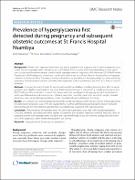| dc.contributor.author | Nakabuye, Betty | |
| dc.contributor.author | Bahendeka, Silver | |
| dc.contributor.author | Byaruhanga, Romano | |
| dc.date.accessioned | 2021-10-27T13:44:55Z | |
| dc.date.available | 2021-10-27T13:44:55Z | |
| dc.date.issued | 2017-05-02 | |
| dc.identifier.citation | Nakabuye, B., Bahendeka, S. and Byaruhanga, R., 2017. Prevalence of hyperglycaemia first detected during pregnancy and subsequent obstetric outcomes at St. Francis Hospital Nsambya. BMC research notes, 10(1), pp.1-10. | en_US |
| dc.identifier.issn | 1756-0500 | |
| dc.identifier.uri | http://hdl.handle.net/20.500.12280/2845 | |
| dc.description.abstract | Background: Women with hyperglycaemia detected during pregnancy are at greater risk for adverse pregnancy outcomes. Data on hyperglycaemia in pregnancy in sub-Saharan Africa is scanty and varied depending on the populations studied and the methodologies used to defne hyperglycaemia in pregnancy. With the recent 2013 World Health
Organisation (WHO) diagnostic criteria and classifcation, there is yet no sufcient data on the prevalence of hyperglycaemia in sub-Saharan Africa. The objective was to determine the prevalence of Hyperglycaemia frst detected during
pregnancy and subsequent obstetric outcomes among patients attending antenatal care (ANC) at St. Francis Hospital
Nsambya.
Methods: A prospective cohort study. All women with no history of diabetes mellitus attending at or after 24 weeks
gestation were eligible to participate in the study. Participants underwent a standard 75 g oral glucose tolerance test
(OGTT) after an informed written consent. The primary outcome was diagnosis of hyperglycaemia. Enrolled participants were followed up to delivery to assess obstetric outcomes (secondary outcomes were birth weight, neonatal
admission, maternal genital trauma, delivery mode, neonatal and maternal status at discharge).
Results: 251 women were screened between December 2013 and February 2014. The prevalence of hyperglycaemia
frst detected in pregnancy was 31.9%. We found 23.8 % of women with hyperglycaemia had no known risk factor.
Macrosomia was the only obstetric outcome that was signifcantly associated with hyperglycaemia.
Conclusion: The prevalence of hyperglycaemia frst detected in pregnancy was high in the studied population.
Clinicians, therefore, should become more vigilant to screen for the condition. Selective screening may miss 23.8% of
pregnant women with hyperglycaemia. However the cost/beneft implications of screening strategy and the recent
2013 WHO diagnostic criteria need to be studied in our setting. | en_US |
| dc.language.iso | en | en_US |
| dc.publisher | BMC | en_US |
| dc.relation.ispartofseries | BMC research notes;10:174 | |
| dc.subject | Hyperglycaemia | en_US |
| dc.subject | Screening and pregnancy | en_US |
| dc.title | Prevalence of hyperglycaemia frst detected during pregnancy and subsequent obstetric outcomes at St. Francis Hospital Nsambya | en_US |
| dc.type | Article | en_US |


